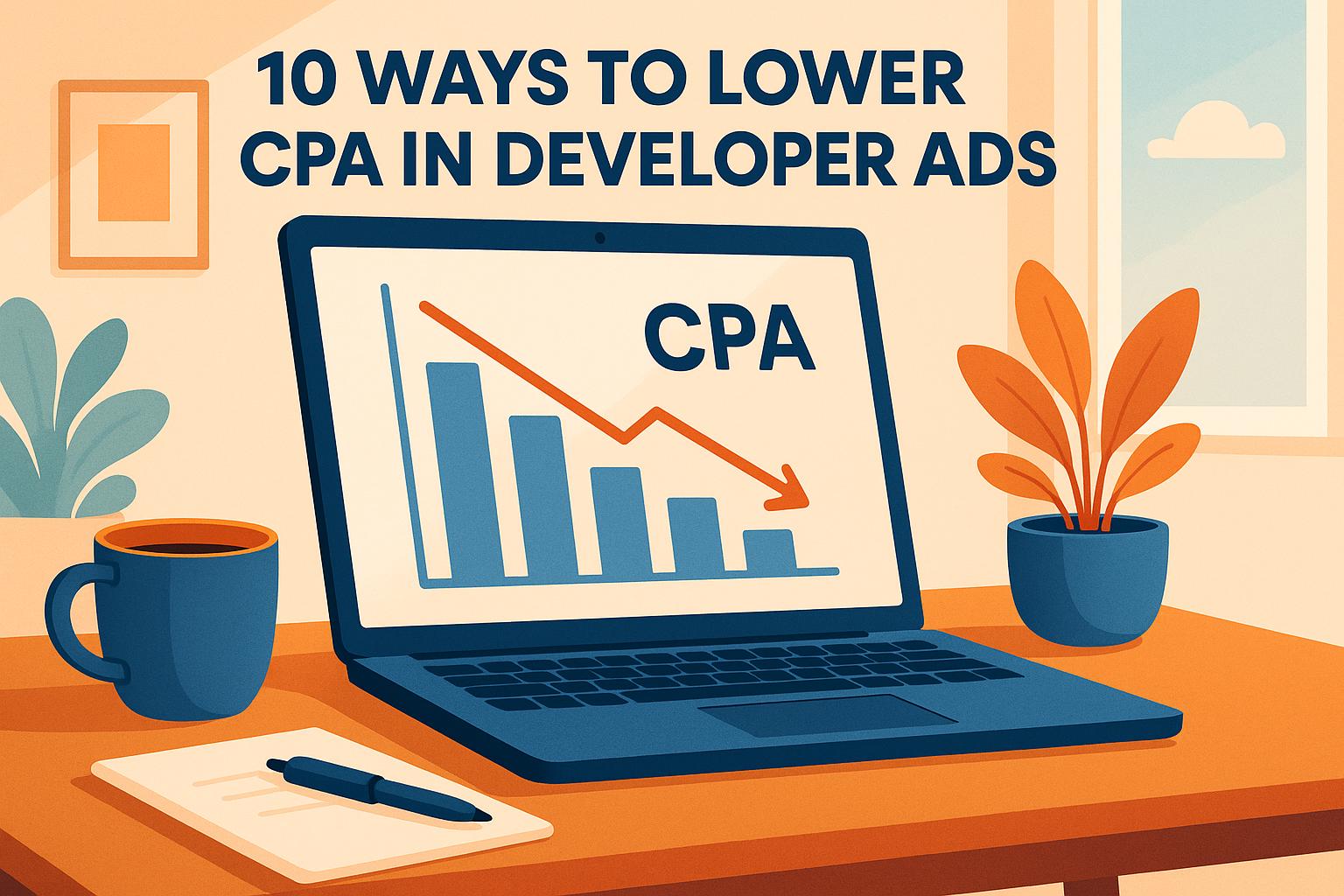


Effective developer marketing requires understanding your audience, crafting precise messages, and choosing the right platforms for engagement.
- Know your audience: Developers vary by skill, experience, and tools. A junior React developer has different needs than a senior DevOps engineer. Segment your audience by use case, experience, and tech stack to avoid wasting resources.
- Craft the right message: Developers dislike fluff. Highlight how your product solves their problems - like saving time, improving code quality, or addressing security issues. Use clear, direct language that matches their vocabulary.
- Choose the right platform: Reach developers where they are. Platforms like daily.dev Ads let you target by programming language, seniority, and tools, ensuring your message lands with the right people.
Why this matters: Pre-launch planning reduces risks and boosts impact. Campaigns with clear goals are 429% more likely to succeed. Skip the prep, and you risk misalignment and wasted budget. Start with these three questions to set your campaign up for success.
How I think about Developer Marketing
Question 1: Who Is Your Target Developer Audience?
Developers come in all shapes and sizes, with a wide range of skills, experience levels, and goals. Casting too wide a net with your targeting can drain your advertising budget fast. Why? Because when you try to appeal to everyone, you risk resonating with no one.
Why Precise Targeting Matters
Getting to know your audience - their skills, seniority, and tools - makes your campaign far more effective. Think about it: a junior JavaScript developer working on their first React app has entirely different priorities than a senior DevOps engineer handling infrastructure for a large-scale application. Personalization makes a difference - 81% of consumers prefer brands that tailor their messaging to their needs, and developers are no exception.
Take DigitalOcean, for example. Instead of targeting all developers, they focus on specific use cases, like those looking for simple and fast cloud hosting solutions. They create tutorials that address real-world challenges in cloud hosting and system administration, all while avoiding pushy calls-to-action. Their clean, straightforward approach resonates because it aligns with their audience's needs.
Similarly, GitLab places display ads on platforms developers already frequent. Their ads highlight features that matter most to their audience, like ease of use and powerful tools, ensuring they connect with developers in the right context.
How to Segment Your Developer Audience
The first step to effective targeting is understanding how developers interact with your product. Start by breaking your audience into segments based on their primary use case: are they building, integrating, automating, or securing something with your solution?
Next, consider their experience level and industry. Junior developers often look for educational resources and guidance, mid-level engineers prioritize tools that improve efficiency, and senior architects focus on scalability, security, and team productivity. A startup developer juggling limited resources has entirely different concerns than an enterprise engineer navigating compliance requirements.
Technology stack is another key factor. A Python developer working with Django has distinct interests compared to a Node.js developer using Express. Knowing the programming languages, frameworks, and tools your audience relies on allows you to communicate in a way that feels authentic and relevant.
To refine your segmentation, combine insights from multiple sources. Conduct developer interviews, participate in forum discussions, monitor GitHub issues, and dive into Slack communities. Then, back up this qualitative data with quantitative insights from product analytics, content engagement metrics, and surveys. Together, these methods help you create detailed audience profiles, laying the groundwork for advanced targeting tools like daily.dev Ads.
Using daily.dev Ads for Advanced Targeting

Once you’ve segmented your audience, daily.dev Ads can take your targeting to the next level. With access to over 1 million developers worldwide, the platform offers advanced filters that go beyond basic demographics. You can target based on seniority, programming languages, and specific tools.
For instance, if you’re promoting a React testing library, daily.dev Ads ensures your campaign reaches developers who actively use React. You can also tailor messaging by seniority: advertise entry-level courses to junior developers while showcasing enterprise-grade features to senior engineers and technical leads. Need to focus on a particular region? Hyper-local targeting has you covered.
What’s more, native ad placements - such as in-feed ads, post page ads, and personalized digest ads - blend seamlessly into developers’ daily routines, leading to higher engagement. And with real-time performance tracking, you can see which segments respond best, allowing you to fine-tune your strategy as you go.
Question 2: What Message Will Connect with Developers?
The challenge here is crafting a message that truly speaks to developers. They tend to be skeptical of marketing fluff and prefer communication that’s straightforward, honest, and practical. Developers don’t just want to know what your product does - they want to see how it solves their specific problems and makes their work more efficient. Addressing these needs directly is key to creating a message that resonates.
Understanding Developer Pain Points and Interests
Developers often grapple with issues like unclear requirements, outdated codebases, scope creep, and poor communication. For instance, 33% of developers identify vague requirements as their biggest hurdle. Meanwhile, the U.S. Bureau of Labor Statistics predicts a 17% growth in software engineering jobs between 2023 and 2033, signaling a growing demand for solutions that ease these challenges. Security is another major concern - one study revealed that 96% of web applications have at least one serious vulnerability.
Your message should reflect these realities. Instead of focusing solely on features, emphasize how your product addresses these pain points. For example, if you’re marketing a testing tool, highlight its ability to catch bugs early, reduce debugging time, or integrate smoothly into existing CI/CD pipelines. Show how your solution improves documentation, reduces technical debt, streamlines teamwork, or enhances code quality.
Best Practices for Writing Developer-Focused Ad Copy
To connect with developers, your ad copy needs to be clear and to the point. Start with action-oriented language like "Discover", "Experience", or "Unlock." Use "you" to create a personal connection and include specific numbers to build credibility. Match the tone and terminology developers use in their discussions to make your message feel natural. Focus on the benefits your product delivers rather than just listing features, and directly address common frustrations developers face.
Social proof can also enhance your message. Include testimonials or adoption metrics to build trust. For example, with 83% of landing page visits in 2024 coming from mobile devices, ensure your copy is optimized for smaller screens by keeping headlines concise and key points easy to grasp.
Testing and Refining Your Message
Once you’ve crafted your message, test it to see how well it resonates. Message testing allows you to evaluate its effectiveness with your audience. Start by setting clear goals - whether you’re identifying which pain points matter most, comparing value propositions, or balancing technical and business-focused messaging. Use a mix of qualitative methods (like interviews or feedback from developer forums) and quantitative tools (such as A/B testing or surveys) to gather actionable insights.
Experiment with different elements, including headlines, calls-to-action, and the level of technical detail in your messaging. Assess factors like clarity, accuracy, appeal, and relevance to ensure your message hits the mark. Regularly review your results to adapt to shifting trends and keep your communication fresh.
"The message that is going to get the word out there that your product exists or your brand exists are going to be different… at different stages of a customer's journey. You need data to know what works and when." - Ben Cortese, Vice President, KS&R
The goal isn’t to get everything perfect right away. Instead, focus on refining your message through ongoing feedback. This iterative process ensures your messaging stays relevant and effective as your campaign evolves.
sbb-itb-e54ba74
Question 3: Which Platform Will Reach Your Developers Best?
Choosing the right platform is crucial for ensuring your campaign not only reaches developers but also resonates with them effectively. The platform you choose will shape both the extent of your reach and how well your message connects with your target audience.
Platform Evaluation Criteria
When evaluating developer advertising platforms, consider four key factors: audience reach, ad formats, performance tracking, and targeting precision. These elements collectively determine whether a platform can deliver the outcomes you’re aiming for.
- Audience reach: It’s not just about the numbers. Understanding who the developers are is just as important as knowing how many there are. Are they frontend specialists, backend engineers, or full-stack developers? What’s their level of experience? For example, a platform with 100,000 senior developers may be more valuable than one with 500,000 users of mixed experience levels, depending on your product.
- Ad formats: Developers interact with content in unique ways. Native ads that seamlessly blend into the platform’s content typically perform better than banner ads, which are often ignored or blocked. Look for platforms offering options like sponsored articles or newsletter placements that integrate naturally with the content developers already trust.
- Performance tracking: To optimize your campaigns effectively, you need real-time insights into metrics like impressions, clicks, conversions, and engagement rates. These metrics help you assess whether your campaigns are hitting the mark and delivering the return on investment you expect.
- Targeting precision: The ability to fine-tune your audience targeting is critical. Platforms that allow you to narrow your focus by criteria like programming languages, tools, seniority levels, company size, or geographic location will help you align your message with the developers most likely to engage with your product.
Additionally, consider the platform’s credibility within the developer community. Developers tend to be skeptical of marketing, so advertising on platforms they already trust can significantly improve engagement. Opt for platforms that uphold editorial standards and provide genuine value to their audience beyond just advertising.
Advantages of daily.dev Ads
daily.dev Ads stands out by reaching over 1 million active developers worldwide, offering targeted and contextually relevant engagement.
- Native ad placements: Ads on daily.dev integrate naturally with the content developers are already consuming. This is particularly important given that the average human attention span is just 8 seconds. Ads that feel organic and valuable are far more likely to capture attention than those that disrupt the user experience.
- Precision targeting: The platform enables you to target developers based on their seniority, preferred programming languages, and specific tools in their tech stack. For example, you can reach React developers working at startups or senior Python engineers in enterprise companies, ensuring your message reaches the right audience.
- Real-time performance tracking: daily.dev provides immediate access to metrics like impressions, clicks, engagement, and conversions. This allows you to make quick adjustments, such as reallocating budgets from underperforming campaigns to those delivering better results.
- Expert creative guidance: The platform’s team offers support to optimize your campaigns, helping you craft messaging that resonates with developers. They understand the nuances of developer culture and can help you avoid common pitfalls that might alienate your audience.
Using a Comparison Table for Platform Selection
To make an informed decision, create a structured comparison of potential platforms. This approach helps you evaluate options objectively rather than relying on assumptions or marketing claims. Use a table like the one below to compare platforms based on key criteria:
| Platform Feature | Evaluation Criteria | Questions to Ask |
|---|---|---|
| Audience Quality | Developer focus, experience levels, engagement | What percentage of users are developers? What’s the mix of junior vs. senior developers? How engaged are they? |
| Targeting Options | Programming languages, tools, seniority, geography | Can I target specific developer types like React or Python users? How granular are the targeting options? |
| Ad Formats | Native placements, sponsored content, banners | Do ads blend naturally with platform content? Which formats perform best for developers? |
| Performance Tracking | Real-time analytics, conversion tracking, attribution | Can I track conversions to specific ads? How quickly is performance data updated? |
| Pricing Model | CPM, CPC, flat rates, minimum spends | What’s the cost structure? Are there minimum commitments? How does pricing compare to expected ROI? |
When filling out your comparison table, focus on measurable data rather than subjective impressions. Request detailed information from platform representatives about audience demographics, engagement rates, and typical campaign results. If possible, ask for case studies from companies with similar goals to gauge what you can realistically expect.
Ultimately, the best platform isn’t necessarily the one with the largest reach or the lowest cost. Instead, it’s the one that aligns most closely with your specific goals, target audience, and budget. A smaller, highly targeted platform may deliver better results than a general-purpose advertising network, especially when your aim is to connect with developers who value relevance and authenticity.
Use this comparison framework as a dynamic tool throughout your campaign planning. Update it as you gather new insights and refine your strategy to ensure your platform choice continues to align with your evolving goals.
Pre-Launch Checklist and Success Metrics
Launching a campaign without a solid plan is like setting off on a road trip without a map - you’re bound to miss something important. A well-organized checklist ensures your team stays on the same page, while tracking the right metrics lets you see if your campaign is hitting the mark. This checklist connects your planning efforts with measurable results, giving your campaign the best chance to succeed.
When preparing for launch, align your steps with the developer-focused strategies discussed earlier to make sure your campaign makes an impact from day one.
Tasks to Complete Before Launch
Validate your audience to ensure your campaign targets the right people. Double-check that your audience parameters, like developer segments, programming languages, and company profiles, match your goals. Your audience should be large enough to generate results but specific enough to avoid wasting resources.
Test your messaging by running A/B tests on your ad copy and visuals before committing your full budget. Try out different headlines, calls-to-action, and value propositions on small audience samples to see what resonates most - whether it’s a more technical tone or a business-focused approach.
Set up your platforms by configuring tracking pixels, conversion goals, and attribution models. Test your landing pages to ensure they’re optimized for traffic across all devices, from desktops to smartphones.
Check for compliance to avoid delays or rejections. Review advertising policies for each platform, especially when making technical claims or comparisons of developer tools. Make sure your ads meet size and quality standards and that any promotional offers or pricing details are accurate.
Coordinate with your team by briefing sales on campaign messaging, preparing support teams with FAQs, and setting up real-time monitoring tools to track campaign performance.
Confirm your budget and timeline to avoid surprises mid-campaign. Finalize your spending limits, campaign duration, and key milestones. Have a plan in place to address any performance issues that might arise.
Once these tasks are completed, shift your focus to tracking the metrics that matter.
Key Metrics to Track
Engagement metrics like click-through rates (CTR) offer a quick snapshot of how developers are responding to your campaign. On average, search ads see a 6.6% CTR, while display ads hover around 0.6%.
Conversion rates measure whether engagement leads to meaningful actions, like sign-ups or trial-to-paid upgrades. These metrics help you see if your campaign is driving real business outcomes.
Cost efficiency metrics, such as cost per click (CPC) and cost per lead (CPL), show how effectively you’re spending your budget. These figures help identify which audience segments and ad variations deliver the most value.
Lead quality ensures you’re attracting developers who match your ideal customer profile. Differentiate between Marketing Qualified Leads (MQLs) and Sales Qualified Leads (SQLs) to refine your outreach strategy.
Brand awareness indicators track your campaign’s broader impact. Metrics like branded keyword searches, brand mentions, and social media engagement reveal how well your campaign is boosting recognition within the developer community.
Email performance is crucial if your campaign involves newsletters or nurturing sequences. Monitor open rates (average 21.33%) and click-through rates (2–5%) to assess effectiveness. Email campaigns can deliver a high return on investment, with $38 earned for every dollar spent.
Focus on metrics that align directly with your campaign goals, steering clear of vanity metrics that don’t offer actionable insights. During the first week, set up automated reporting to monitor performance daily, then transition to weekly reviews once you have a clearer picture. Custom dashboards can help you quickly identify trends and make data-driven adjustments. Keep in mind that developer campaigns often require longer consideration periods than consumer-focused ones, so patience and long-term tracking are key to understanding your campaign’s full impact.
Conclusion: Launch with Confidence
Answering three key questions - Who is your target developer audience? What message will resonate with them? Which platform will best reach them? - turns guesswork into a clear, actionable strategy. These questions ensure your campaign aligns with your business goals, connects with the right audience, and delivers measurable outcomes.
Crafting messaging that speaks directly to your audience can boost conversions and foster loyalty. A consistent brand message, one that reflects your values and identity, enhances recognition and trust while improving the overall customer experience. As Robert W. Bly explains in The Copywriter's Handbook:
"For copy to convince the consumer to buy the product, it must do four things: Get attention, Communicate, Persuade, Ask for a response".
This advice highlights the importance of making thoughtful, data-driven adjustments after launch.
Post-launch optimization is where campaigns truly take shape. Regularly monitor sales data, gather customer feedback, and stay on top of market trends to refine your approach. Launch day is just the beginning - long-term success hinges on continuous improvement fueled by insights from A/B testing, performance metrics, and developer feedback.
Developers value transparency and authentic engagement. Building trust involves more than just marketing; it means offering educational resources, participating in industry conversations, and actively engaging on social platforms. Personalization is also key: 68% of consumers now expect tailored experiences, and word of mouth influences 20% to 50% of all purchasing decisions. These numbers emphasize the power of personalized interactions and organic advocacy in driving success. By consistently delivering value, you'll create loyal advocates who naturally amplify your message.
FAQs
How can I identify and target the right developer audience for my campaign?
To connect with the right developers, it’s essential to start by understanding their job roles, skill levels, and technical interests. Dive deeper into their habits - what platforms they frequent, the type of content they engage with, and their go-to communication channels.
Segmenting your audience based on their unique needs and challenges can make all the difference. For instance, junior developers might focus on finding learning materials to grow their skills, while senior developers are more likely to appreciate tools that streamline their workflows. By customizing your campaign around these insights, you can create messaging that truly resonates and encourages meaningful interactions.
How can you create ad messages that truly connect with developers and avoid common marketing mistakes?
To create ad messages that truly connect with developers, focus on being clear, genuine, and focused on value. Skip the buzzwords and opt for straightforward language that speaks to their goals and pain points. Show how your product or service directly addresses their challenges and delivers meaningful solutions.
Keep your message sharp and to the point. Use simple visuals, concise copy, and a strong call-to-action that drives engagement. Invest time in understanding your audience by studying developer personas and behaviors. Tailor your message to align with their specific interests and needs. Thoughtful personalization goes a long way in building trust and forming real connections.
What’s the best way to choose a platform that effectively reaches developers and maximizes campaign success?
To connect with developers effectively, it's crucial to choose platforms that are popular and well-regarded in the developer community. Focus on platforms that allow targeted outreach based on specific skills, interests, and behaviors, while also demonstrating strong engagement with technical audiences.
Look for platforms offering ad formats tailored to developers, ensuring they align with the goals of your campaign. Take into account their reputation for reliability and trust within the developer space, and confirm they fit comfortably within your budget. Once your campaign is running, keep an eye on performance metrics to fine-tune your platform selection and achieve the best possible results.






